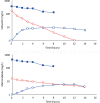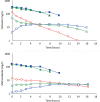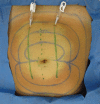Prevention of Surgical Site Infections and Biofilms: Pharmacokinetics of Subcutaneous Cefazolin and Metronidazole in a Tumescent Lidocaine Solution
- PMID: 28607871
- PMCID: PMC5459654
- DOI: 10.1097/GOX.0000000000001351
Prevention of Surgical Site Infections and Biofilms: Pharmacokinetics of Subcutaneous Cefazolin and Metronidazole in a Tumescent Lidocaine Solution
Abstract
Background: Tumescent anesthesia antibiotic delivery (TAAD) consists of subcutaneous infiltration of antibiotic(s) dissolved tumescent lidocaine anesthesia. Tumescent lidocaine anesthesia contains lidocaine (≤ 1 g/L), epinephrine (≤ 1 mg/L), sodium bicarbonate (10 mEq/L) in 0.9% saline. Our aim was to measure cefazolin and metronidazole concentrations over time in subcutaneous tumescent interstitial fluid (TISF) after TAAD, in serum after TAAD and after intravenous antibiotic delivery (IVAD). We hypothesize that the pharmacokinetic/pharmacodynamic profiles of TAAD + IVAD are superior to IVAD alone for the prevention of surgical site infections and biofilms.
Methods: Concentrations of cefazolin and metronidazole in TISF and serum following TAAD and in serum following IVAD were compared in 5 female volunteers. Subjects received cefazolin or cefazolin plus metronidazole by IVAD alone and by TAAD alone. One subject also received concomitant IVAD and TAAD of these 2 antibiotics. Sequential samples of serum or subcutaneous TISF were assayed for antibiotic concentration.
Results: Cefazolin (1 g) by TAAD resulted in an area under the curve of the concentration-time profile and a maximum concentration (Cmax) in subcutaneous tissue that were 16.5 and 5.6 times greater than in serum following 1 g by IVAD. Metronidazole (500 mg) by TAAD resulted in an area under the curve and Cmax that were 8.1 and 24.7 times greater in TISF, than in serum after 500 mg by intravenous delivery. IVAD + TAAD resulted in superior antibiotic concentrations to IVAD alone.
Conclusions: TAAD + IVAD produced superior antibiotic bioavailability in both subcutaneous interstitial fluid and serum compared with IVAD alone. There was no evidence that TAAD of cefazolin and metronidazole poses a significant risk of harm to patients.
Figures











Similar articles
-
Estimated Maximal Safe Dosages of Tumescent Lidocaine.Anesth Analg. 2016 May;122(5):1350-9. doi: 10.1213/ANE.0000000000001119. Anesth Analg. 2016. PMID: 26895001 Free PMC article. Clinical Trial.
-
The tumescent technique: the effect of high tissue pressure and dilute epinephrine on absorption of lidocaine.Plast Reconstr Surg. 1999 Mar;103(3):990-6; discussion 997-1002. Plast Reconstr Surg. 1999. PMID: 10077095 Clinical Trial.
-
When one liter does not equal 1000 milliliters: implications for the tumescent technique.Dermatol Surg. 2000 Nov;26(11):1024-8. doi: 10.1046/j.1524-4725.2000.0260111024.x. Dermatol Surg. 2000. PMID: 11096388
-
Tumescent technique for regional anesthesia permits lidocaine doses of 35 mg/kg for liposuction.J Dermatol Surg Oncol. 1990 Mar;16(3):248-63. doi: 10.1111/j.1524-4725.1990.tb03961.x. J Dermatol Surg Oncol. 1990. PMID: 2179348 Review.
-
Tumescent anaesthesia: its applications and well tolerated use in the out-of-operating room setting.Curr Opin Anaesthesiol. 2017 Aug;30(4):518-524. doi: 10.1097/ACO.0000000000000486. Curr Opin Anaesthesiol. 2017. PMID: 28509770 Review.
Cited by
-
Empiric intralesional tumescent drug delivery of antimicrobials effectively treated a painful necrotizing skin infection.JAAD Case Rep. 2024 Mar 26;50:40-43. doi: 10.1016/j.jdcr.2024.03.008. eCollection 2024 Aug. JAAD Case Rep. 2024. PMID: 39036615 Free PMC article. No abstract available.
References
-
- Boehm O, Baumgarten G, Hoeft A. Epidemiology of the high-risk population: perioperative risk and mortality after surgery. Curr Opin Crit Care. 2015;21:322–327.. - PubMed
-
- Viet Hung N, Anh Thu T, Rosenthal VD, et al. Surgical site infection rates in seven cities in Vietnam: findings of the International Nosocomial Infection Control Consortium. Surg Infect (Larchmt). 2016;17:243–249.. - PubMed
-
- Toma O, Suntrup P, Stefanescu A, et al. Pharmacokinetics and tissue penetration of cefoxitin in obesity: implications for risk of surgical site infection. Anesth Analg. 2011;113:730–737.. - PubMed
-
- Hu H, Johani K, Almatroudi A, et al. Bacterial biofilm infection detected in breast implant-associated anaplastic large-cell lymphoma. Plast Reconstr Surg. 2016;137:1659–1669.. - PubMed
LinkOut - more resources
Full Text Sources
Other Literature Sources
Medical
